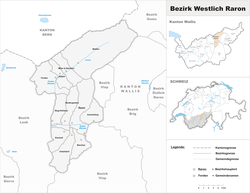Westlich Raron (district)
|
Westlich Raron Bezirk Westlich Raron |
|
|---|---|
| District | |
 |
|
| Country |
|
| Canton |
|
| Capital | Raron |
| Area | |
| • Total | 266.3 km2 (102.8 sq mi) |
| Population (2015) | |
| • Total | 7,852 |
| • Density | 29/km2 (76/sq mi) |
| Time zone | CET (UTC+1) |
| • Summer (DST) | CEST (UTC+2) |
| Municipalities | 11 |
The district of Westlich Raron (fr. Rarogne occidental) is an administrative district in the canton of Valais, Switzerland. The districts of Östlich Raron and Westlich Raron share a single Community Identification Number of SFOS number (2309). The district of Westlich Raron has a population of 7,852, while the Raron District has a population of 10,844 (as of 31 December 2015).
It includes the following municipalities:
7,852
The blazon of the district coat of arms is Gules a vine eradicated Vert rooted Maroon and fructed Or.
Raron has a population (as of December 2015[update]) of 10,844. Most of the population (as of 2000[update]) speaks German (9,979 or 96.1%) as their first language, Albanian is the second most common (89 or 0.9%) and French is the third (88 or 0.8%). There are 45 people who speak Italian and 2 people who speak Romansh.
Of the population in the entire district 5,957 or about 57.4% were born in Raron and lived there in 2000. There were 2,694 or 26.0% who were born in the same canton, while 858 or 8.3% were born somewhere else in Switzerland, and 614 or 5.9% were born outside of Switzerland. As of 2000[update], there were 4,317 people who were single and never married in the district. There were 5,217 married individuals, 590 widows or widowers and 256 individuals who are divorced.
There were 1,000 households that consist of only one person and 326 households with five or more people. Out of a total of 4,035 households that answered this question, 24.8% were households made up of just one person and there were 75 adults who lived with their parents. Of the rest of the households, there are 1,020 married couples without children, 1,537 married couples with children There were 178 single parents with a child or children. There were 91 households that were made up of unrelated people and 134 households that were made up of some sort of institution or another collective housing.
...
Wikipedia
